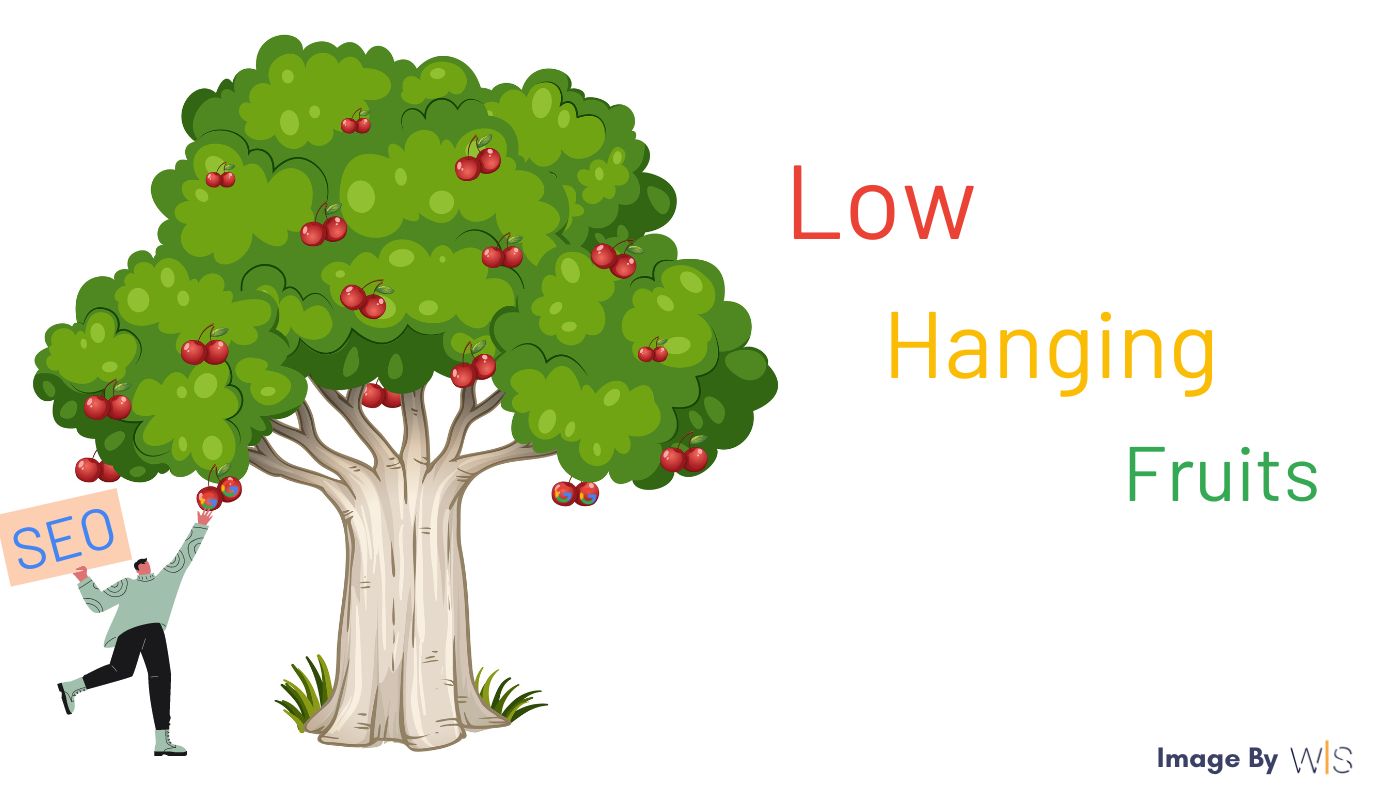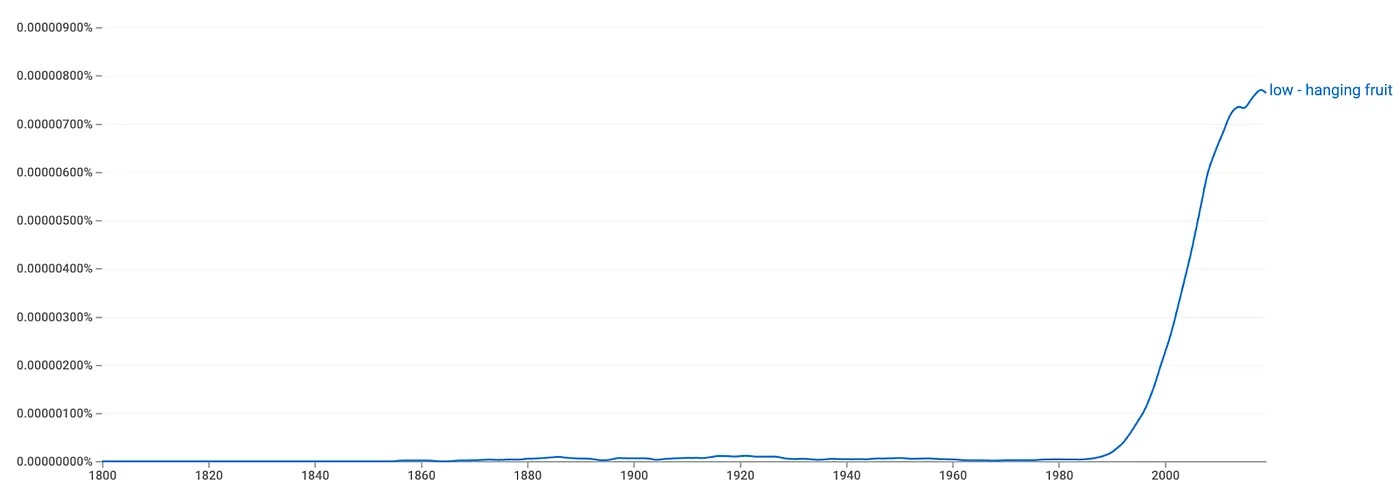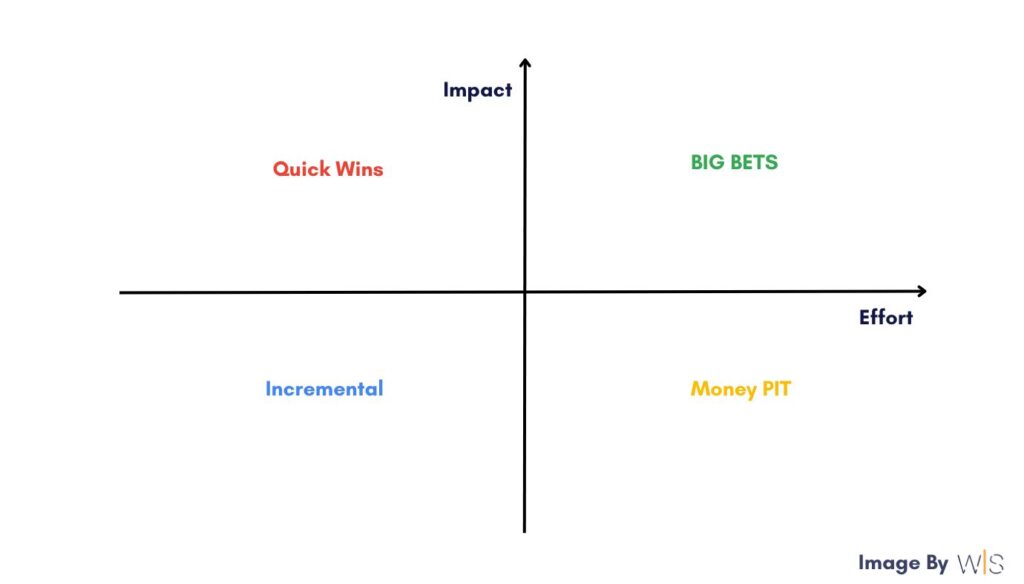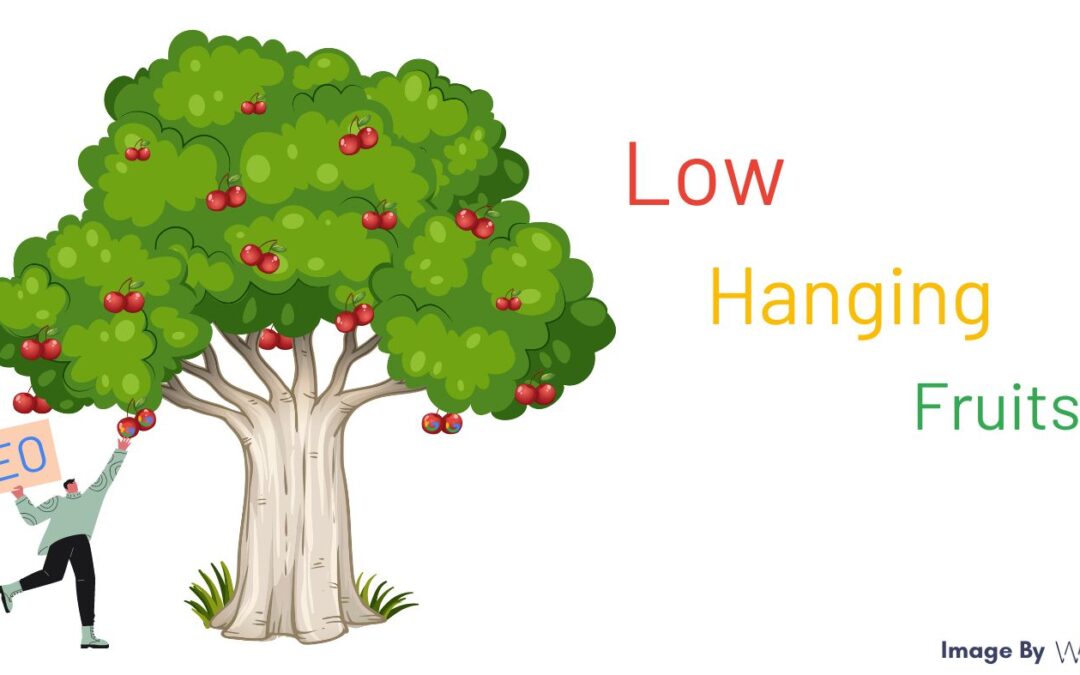Understanding Low Hanging Fruit in SEO | Quick Wins | Pick Your Fruit

In the world of SEO (Search Engine Optimization), where ranking high on search results is a constant battle, the concept of “low-hanging fruit” takes centre stage. But what exactly does it mean, and how can it benefit marketers?
Origin of the Term
The term “low-hanging fruit” has its roots in the literal sense. Imagine an orchard overflowing with ripe fruit. The easiest to pick, of course, are the ones hanging low on the branches, requiring minimal effort. In SEO, this metaphor translates to tasks or optimisations that can be readily implemented and deliver quick wins in terms of website traffic and ranking.
The phrase ‘low-hanging fruit’ traces back to the 17th century, gaining significant traction after a 1968 Guardian article by P. J. Kavanaugh. Its usage surged in the early 1990s, becoming a widely recognized metaphor.

Figure 1: Historical Usage of ‘Low-Hanging Fruit’
Understanding Low-Hanging Fruit SEO
While SEO strategies often involve complex, long-term plans, low-hanging fruit represents the easy-to-fix technical issues and basic optimisations that can yield significant results in a shorter time frame. Here are some examples:
-
Claiming and verifying your Google My Business listing:
This ensures your business appears in local search results, a crucial factor for local SEO.
-
Optimising title tags and meta descriptions:
Compelling and keyword-rich titles and descriptions can significantly improve click-through rates from search results.
-
Improving website speed:
A slow loading website is a surefire way to lose visitors and hurt your ranking. Optimising images and code can significantly improve website speed.
-
Fixing broken links:
Broken links not only frustrate users but also indicate a lack of website maintenance to search engines.
Low hanging fruit SEO revolves around identifying areas with low competition and high potential for quickly elevating search engine rankings. These are the domains where your website can shine without requiring hefty investments or extensive resources. By recognizing and seizing these openings, you can gradually enhance your website’s SEO performance and reap the benefits of increased organic traffic.
Benefits of Low-Hanging Fruit for Marketers
For marketers, focusing on low-hanging fruit offers a multitude of benefits:
-
Improved ranking and visibility:
Addressing basic SEO issues can lead to a quick rise in search engine rankings, making your website more visible to potential customers.
-
Increased website traffic:
Higher visibility translates to more visitors to your website, expanding your reach and potential customer base.
-
Enhanced user experience:
A well-optimised website with clear navigation and fast loading times provides a better user experience, keeping visitors engaged and improving conversion rates.
-
Frees up resources for complex strategies:
By tackling the easy wins first, marketers can free up valuable time and resources to focus on more complex and long-term SEO strategies.
Remember: While low-hanging fruit is a great way to get started and see quick results, it shouldn’t be the only focus of your SEO strategy. A well-rounded approach that combines both low-hanging fruit with ongoing content creation, link building, and technical SEO is crucial for sustainable success in the competitive world of search engine optimization.
Exploring 10 Low Hanging Fruit SEO Strategies with Ahrefs
1. Targeting Long-Tail Keywords:
Long-tail keywords are specific phrases with less competition but high relevance. Use Ahrefs’ Keyword Explorer to uncover pertinent long-tail keywords in your niche and craft content tailored to their nuances.
2. Analysing Competitor Backlinks:
Dive into your competitors’ backlink profiles using Ahrefs’ Site Explorer. Identify websites linking to your competitors but not to your own site, and establish connections with these potential link sources to acquire high-quality backlinks.
3. Conducting Content Gap Analysis:
Utilise Ahrefs’ content gap tool to identify keywords where your competitors are ranking but your site isn’t. Develop content focusing on these keywords to bridge the gap and attract organic traffic.
4. Enhancing Existing Content:
Leverage Ahrefs’ Site Audit feature to uncover content with untapped potential despite low organic traffic. Revitalise and optimise these pages to boost their rankings.
5. Rectifying Broken Links:
Broken links can tarnish user experience and hinder SEO efforts. Ahrefs’ Site Audit identifies and assists in fixing broken links on your website, fostering a healthier site environment.
6. Optimising Title Tags and Meta Descriptions:
Ahrefs’ Site Audit pinpoints pages with subpar title tags and meta descriptions. Enhance these elements to improve click-through rates from SERPs.
7. Resolving Keyword Cannibalization:
Identify instances where multiple pages on your site compete for the same keyword. Utilise Ahrefs’ tools to consolidate and redirect these pages, streamlining your SEO strategy.
8. Discovering Orphaned Content:
Ahrefs’ Site Audit uncovers pages on your site lacking internal links. Seamlessly integrate these orphaned pages into your website structure to enhance their discoverability and potential for better rankings.
9. Improving Page Load Speed:
Identify pages with sluggish loading times using Ahrefs’ Site Audit. Optimise these pages by compressing images, enabling browser caching, and refining server response times.
10. Optimising Local SEO:
Evaluate your local SEO endeavours with Ahrefs’ tools. Ensure consistency in your Name, Address, and Phone number (NAP) across directories, and focus on cultivating positive reviews.
Low Hanging Fruit and Google Search Console
Exploration or “Seeking the Low-Hanging Fruit”
The primary focus is on optimising low hanging fruit within existing rankings. Utilising free tools within the realms of a limited budget to maximise outcomes is central to this concept.
To begin with, utilise the Google Search Console for analysing your rankings positioned between 10 and 20. This platform consistently offers the most reliable data and insightful analytics.

Referencing Figure 1:
Identifying low-hanging fruit in the Google Search Console, navigate to the “Performance on search results” report within the Google Search Console. Apply filters for keywords within the past 12 months, specifically targeting positions 10 to 20, and organise the results in descending order.
Examine the impressions associated with these keywords; they offer significant insights into search volume trends. Nonetheless, for precise data on search volumes for specific keywords, it’s advisable to utilise the Google Keyword Planner.
Identify URLs that hold relevance and exhibit promising potential. This can be accomplished either directly or through querying and subsequently filtering the relevant URL.
Upon selecting a URL and navigating to the “queries” section, a comprehensive list of keywords ranking for that URL becomes accessible. If these keywords align thematically with the content of the URL, it’s recommended to optimise the article accordingly.
The Pitfalls of Prioritization
Rise of the Impact/Effort Matrix
The surge in using ‘low-hanging fruit’ coincides with the widespread adoption of the Impact/Effort Matrix, a popular management consultancy tool.

Figure 2: Example Impact/Effort Matrix
Misleading Prioritisation
Despite its simplicity, the Impact/Effort Matrix can lead to biassed decision-making, favouring ‘Quick Wins’ over more substantial efforts.
Distraction or Solution?
While ‘Quick Wins’ can kickstart progress, reliance on the matrix may divert attention from more significant challenges, potentially hindering long-term growth and innovation.
Conclusion
Low hanging fruit SEO presents a shortcut to success in the fiercely competitive digital marketing landscape. By leveraging the insights and tools provided by Ahrefs, you can identify ripe opportunities and implement targeted enhancements to your website’s SEO performance. Remember, SEO is a continuous journey, demanding ongoing vigilance and adaptation for sustained success.
With Worth IT Solution’s diligence and strategic planning, you can unlock the full potential of Low hanging fruit SEO and witness your website climb the ranks of search engine results pages.

